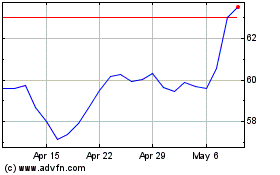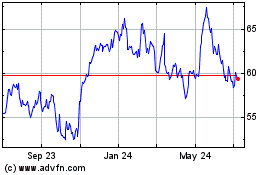Bud's Owner Buys Some Time for Debt Hangover -- Heard on the Street
May 07 2020 - 9:47AM
Dow Jones News
By Carol Ryan
Covid-19 is a perfect storm for Budweiser's owner. But after
holding its own in the first quarter, the company is under less
pressure to sell assets in a weak market as it grapples with a
heavy debt load.
Anheuser-Busch InBev on Thursday said it sold 9.3% less beer
globally in the three months through March compared with the same
period of 2019. Yet the business managed to grow its top line in
the key U.S. market, where consumption is shifting from closed bars
and restaurants to consumers' homes. And although the amount of
beer sold in China almost halved in the first quarter, volumes
started to recover in April.
It could have been worse, and AB InBev's shares were up 5% in
early European trading. However, the stock is still down 44% this
year compared with declines of roughly one-fifth at smaller brewing
rivals Heineken and Carlsberg. The issue, unsurprisingly, is AB
InBev's $80 billion-plus debt load.
The pandemic makes it tough to pay that down. While most of AB
InBev's borrowings are issued in euros and dollars, 60% of the
company's sales are made in emerging markets where currencies have
weakened. Its ratio of net debt to earnings before interest, taxes,
depreciation and amortization is expected to jump to 6.1 times this
year according to analysts at Jefferies, up from 4.5 times at the
end of 2019.
Although investors are now allergic to that level of leverage,
it isn't the right time to sell assets to raise cash. Getting
borrowings down to more acceptable rates of, say, three times
Ebitda, would require AB InBev to find around $26 billion. It could
sell down stakes held in the company's separately listed South
American business AmBev or the recently listed Asian division.
However, the former's shares are down 37% this year and AB InBev
wants to hang on to equity in the Asia business to do regional
deals in the future. A rights issue at the current share price is
also deeply unappealing.
The need to fix AB InBev's balance sheet is pressing and will
remain a dead weight on the company's shares. It has enough cash to
meet its needs for around 24 months, though, and only $3 billion of
its debt matures between now and the end of 2021. Ideally, demand
for beer will recover quickly next year and allow the company to
get its deleveraging plans back on track. But it also needs
exchange rates to move in its favor.
The hangover needs to be dealt with eventually, but the
company's best hope is to delay any drastic moves until the worst
of the pandemic is over.
Write to Carol Ryan at carol.ryan@wsj.com
(END) Dow Jones Newswires
May 07, 2020 09:32 ET (13:32 GMT)
Copyright (c) 2020 Dow Jones & Company, Inc.
Anheuser Busch Inbev SA NV (NYSE:BUD)
Historical Stock Chart
From Aug 2024 to Sep 2024

Anheuser Busch Inbev SA NV (NYSE:BUD)
Historical Stock Chart
From Sep 2023 to Sep 2024
